| Today,
after discovering how the Royal Mail works (40p or 60-cents for a postcard
back to the US), I set off to try to do some *real* sight-seeing for today.
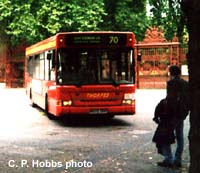 First stop, the
Science Museum. From Queensway/Bayswater, I rode the #70 bus thru Kensington, and got
off at Queensway. (The bus was another of those single-decker, low floor
models). On my way to the Museum, I walked by the
Royal Albert Hall, the
Royal College of Organists
building, and through the Imperial College
campus.
First stop, the
Science Museum. From Queensway/Bayswater, I rode the #70 bus thru Kensington, and got
off at Queensway. (The bus was another of those single-decker, low floor
models). On my way to the Museum, I walked by the
Royal Albert Hall, the
Royal College of Organists
building, and through the Imperial College
campus.


(There was a lot of scaffolding up, as some of these buildings were undergoing
remodeling. But that seems to be true all over London at this time, as
many buildings date back from the 1800's...and earlier)
 The Science Museum...how
can I describe it. Displays on technology in the modern world, gas, diesel
and steam engines, different types of lighting, chemical and nuclear science,
early computers and such...I spent two hours in there and didn't see everything.
(The medical and veternary stuff will have to wait until next trip).
The Science Museum...how
can I describe it. Displays on technology in the modern world, gas, diesel
and steam engines, different types of lighting, chemical and nuclear science,
early computers and such...I spent two hours in there and didn't see everything.
(The medical and veternary stuff will have to wait until next trip).
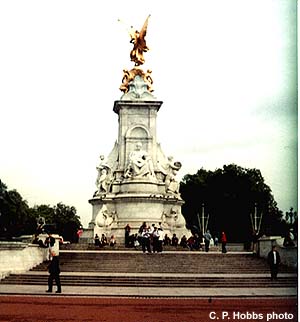

|
Next stop, Buckingham
Palace. From the museum, I walked down a dimly lit subway (remember, in
England a "subway" is an underground walkway, not a transit system) to
the Underground station at South Kensington. From there, I caught the Picadilly
Line to Green Park, and walked along the "Queens Walk" to Buckingham Palace.
As you can expect, there were tourists from all over the world, snapping
pictures. I took my share...Yes, the guards in the red coats and fuzzy
hats were there, putting on a show for us. Of course there were a few "real"
cops around as well.
From the palace,
I walked down to Victoria St. in preparation for my next bus. Before riding
off, though, I visited the Westminster City Hall, which had a small branch
library in
it.
(The library arranged its books rather oddly: instead of
using a pure Dewey Decimal order, it had three letter codes for each subject--"COM"
for computers or "TRA" for travel, and arranged the books by code order.
Strange....)
|
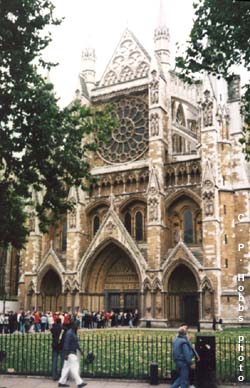
|
Next, I took Bus
#24 to Westminster Abbey and Big Ben. I did hear the bell, although it
can be hard to hear over traffic sometimes. Lunch was fish and chips in
the nearby Methodist church cafeteria...not exactly gourmet, but filling.
I spent a little more time trying to get a good picture of Big Ben and
a red bus, so I could have it and say, "I've been to London".
|
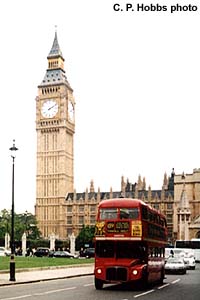
|
Onward. I took Bus
#11 to the Strand/Aldwych, and searched around for awhile for the
London Transport Museum
. It took me awhile to find it (the bus map is not particularly
accurate). It was three blocks away, in a pedestrian plaza called "Covent
Garden".
 The museum was worth
the search. Loaded with historical buses, trains, and even a display of
"London Transport in the Future". (Maglev and flying cars get a mention,
but the main point of the exhibit is alternatives to private autos).
There was a gift shop and I bought a few things, although some prices
seemed high (£3.99--$6 for a
refrigerator magnet
the same size that (Los Angeles) MTA gives us for free?)
The museum was worth
the search. Loaded with historical buses, trains, and even a display of
"London Transport in the Future". (Maglev and flying cars get a mention,
but the main point of the exhibit is alternatives to private autos).
There was a gift shop and I bought a few things, although some prices
seemed high (£3.99--$6 for a
refrigerator magnet
the same size that (Los Angeles) MTA gives us for free?)
Now for some heavy
duty transit geekery. I walked across the Waterloo Bridge and into Waterloo
Train Station (This is where I caught the Eurostar to Paris on Wednesday).
Again, this invoved a walk through a subway, with a couple of sleeping
bums and a sax-playing busker (street musician). I tossed the busker about
20p (30-cents) telling him that I'll pay buskers, but not panhandlers.
Waterloo was the
typical big city train station, like Victoria, Paddington, etc. (All these
places are about as busy as Penn Station in New York, with commuters, long
distance travellers, etc.) I noticed that Eurostar had adopted "until further
notice" some of the same restrictions on carry-on baggage that the airlines
have (no knives, etc.)...
I walked to the Underground
station (another rat-maze, although this one was new and clean) to the
newest Underground line--the Jubilee Line. This route even has a second
set of doors on the platform that only open when a train has stopped there.
The first eastbound
Jubilee Line was packed (it was about 4:30 pm, start of rush hour), so
I waited about 3-minutes for the next one, which was a bit less packed.
The ride was the smoothest of any rail system I've been on so far. I could
have rode it all day, it was so good, but I did want to get some Docklands
Light Rail riding in before it got too late.
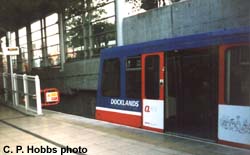 So I got off the
Jubilee at Bank, and walked downstairs to the DLR platforms. (DLR isn't
really "light rail" as we know it...think of it more like the Staten Island
Rapid Transit--without drivers). The route is mostly elevated, with tunnels
in a few places; there are no grade crossings (since there is a third rail,
that's probably a good thing!)
So I got off the
Jubilee at Bank, and walked downstairs to the DLR platforms. (DLR isn't
really "light rail" as we know it...think of it more like the Staten Island
Rapid Transit--without drivers). The route is mostly elevated, with tunnels
in a few places; there are no grade crossings (since there is a third rail,
that's probably a good thing!)
I took a Lewisham-bound
train (There are several DLR routes that go other places in East London
as well). The line travels through an ex-industrial area that is slowly
becoming developed with skyscrapers, etc. But here and there exist a few
run-down neigborhoods. I got off the end of the line at Lewisham. The combined
DLR/train/bus terminal was a rather run-down place loaded with security
cameras. But the staff was helpful, adnd there was even a little snack
shop there.
 Since the Underground
doesn't really cover South London (i.e. south of the Thames) particularly
well, conventional trains fill in. These are single-level, 8-10 car electric
commuter trains. Inside, there is 3+2 seating, like the New Jersey Transit
commuter trains. However the routes of London's commuter train network
are much more complex than Chicago's Metra, or anything running out of
New York. A timetable is a must-have. These trains generally run every
30-minutes offpeak and night, 15-minutes or better during peak hours. For
trips within the zones served by the Travelcard, the same Travelcards that
are used for the bus and the Underground are valid on these trains. There
are supposed to be occasional fare inspections (with penalty fares of £5--about
$7.50), for people without the proper ticket. But no one inspected us on
this trip. Again, this was a commuter-type operation for the most part,
with the train dropping off more passengers than it picked up.
Since the Underground
doesn't really cover South London (i.e. south of the Thames) particularly
well, conventional trains fill in. These are single-level, 8-10 car electric
commuter trains. Inside, there is 3+2 seating, like the New Jersey Transit
commuter trains. However the routes of London's commuter train network
are much more complex than Chicago's Metra, or anything running out of
New York. A timetable is a must-have. These trains generally run every
30-minutes offpeak and night, 15-minutes or better during peak hours. For
trips within the zones served by the Travelcard, the same Travelcards that
are used for the bus and the Underground are valid on these trains. There
are supposed to be occasional fare inspections (with penalty fares of £5--about
$7.50), for people without the proper ticket. But no one inspected us on
this trip. Again, this was a commuter-type operation for the most part,
with the train dropping off more passengers than it picked up.
I rode a Connex train
between Lewisham and Elmers End; the ride took about 20-minutes. The stations
are simple affairs, much like those on Metrolink, Metra, etc. in the U.S.
They're not very handicapped accessible, though (lots of stairs on footbridges
crossing tracks).
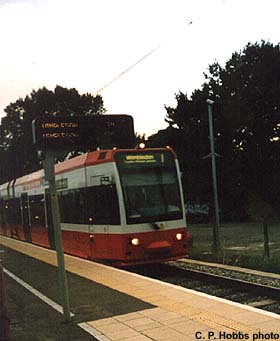 At Elmers End, I
caught the Croydon Tram headed to Wimbledon. There are three tram routes
in Croydon (a city south of London). The trams are more like what would be
called "light rail" in the U.S. (L.A. Metro Blue Line, San Diego Trolley, Portland Max, etc).
In some places they have their own right-of-way (abandoned railroad line);
elsewhere they run in the street, either in exclusive lanes or in mixed
traffic. In downtown Croydon, the tram operator had to get out and turn
a switch manually for some reason--that probably isn't usual. At this time
of day (about 7 p.m.) ridership was heaviest on trips leaving Croydon.
There was a fare inspection somewhere between Downtown Croydon and Wimbledon;
someone (Not me!) almost was asked to leave the train before he finally dug out his
ticket!
At Elmers End, I
caught the Croydon Tram headed to Wimbledon. There are three tram routes
in Croydon (a city south of London). The trams are more like what would be
called "light rail" in the U.S. (L.A. Metro Blue Line, San Diego Trolley, Portland Max, etc).
In some places they have their own right-of-way (abandoned railroad line);
elsewhere they run in the street, either in exclusive lanes or in mixed
traffic. In downtown Croydon, the tram operator had to get out and turn
a switch manually for some reason--that probably isn't usual. At this time
of day (about 7 p.m.) ridership was heaviest on trips leaving Croydon.
There was a fare inspection somewhere between Downtown Croydon and Wimbledon;
someone (Not me!) almost was asked to leave the train before he finally dug out his
ticket!
The entire ride between
Elmer's End and Wimbledon took about 45-minutes.
At Wimbledon station,
I grabbed a quick bite before hopping on the District Line (Underground).
This particular "Underground" line is actually open-cut or even elevated
for much of its route south of Earl's Court station (Fulham Broadway is
underground--think BART through Berkeley!) I got off at Bayswater Station
and headed for the internet cafe to write this up.
Whoo-hoo. And to
think all this could be done with a £4.30 ($7) Travelcard (day pass)...
|
 Finally it was time
to board the British Airways 747. As we walked down the jetway, additional airport security
staff, under the supervision of LAPD officers, were randomly asking people
to step aside for another wanding and a pat-down search. Guess who got
chosen...
Finally it was time
to board the British Airways 747. As we walked down the jetway, additional airport security
staff, under the supervision of LAPD officers, were randomly asking people
to step aside for another wanding and a pat-down search. Guess who got
chosen...
 I got off at Marble Arch, where I *thought* my hotel would
be a simple bus ride away....little did I know.
I got off at Marble Arch, where I *thought* my hotel would
be a simple bus ride away....little did I know.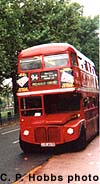 Although the new one-man-operated buses are becoming
more prevalent,
the old traditional "Routemaster" is still very much in evidence. Get on
at the open back platform, pay the conductor when she comes to you (or
show a Travelcard, a day pass that costs £4 or $5.60--probably a
better deal if you ride a lot). and enjoy the ride.
Although the new one-man-operated buses are becoming
more prevalent,
the old traditional "Routemaster" is still very much in evidence. Get on
at the open back platform, pay the conductor when she comes to you (or
show a Travelcard, a day pass that costs £4 or $5.60--probably a
better deal if you ride a lot). and enjoy the ride.
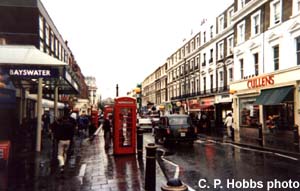 So I got off at Queensway,
walked up the street (lots of shops, stores and restaurants) toward my
hotel. The hotel (Comfort Inn Bayswater) was located in another quiet neighborhood
called Princes Square. I checked in and got settled. (Interesting note:
I flushed the toilet and only saw a trickle of water. Upon calling the
front desk, I learned that I had to depress the handle about three times,
much like priming a pump. You learn something new every day...)
So I got off at Queensway,
walked up the street (lots of shops, stores and restaurants) toward my
hotel. The hotel (Comfort Inn Bayswater) was located in another quiet neighborhood
called Princes Square. I checked in and got settled. (Interesting note:
I flushed the toilet and only saw a trickle of water. Upon calling the
front desk, I learned that I had to depress the handle about three times,
much like priming a pump. You learn something new every day...)
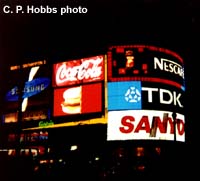 The #12 ran by Piccadilly
Square (full of electronic ads, like Times Square in New York, but somewhat
less intimidating), and back through Oxford Circus and on to my stop at
Queensway.
The #12 ran by Piccadilly
Square (full of electronic ads, like Times Square in New York, but somewhat
less intimidating), and back through Oxford Circus and on to my stop at
Queensway.
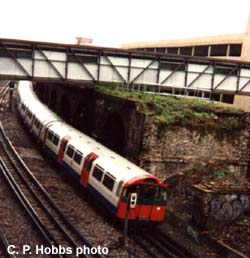 More about the "Underground"...most
of it is underground, although a few places the trains run in an open cut.
Stations, especially interchange stations, can be a twisty maze of passages,
all of which look alike, and lots of stairs (one station had a warning
sign "This staircase has 70 stairs. Use in emergency only". But most stations
have at least escalators, and a few have elevators (lifts). Generally,
stations are clean and kept up, save for a few bits of peeling paint here
and there. There are even vending machines on the platforms, and there
don't seem to be any rules about eating and drinking on the Underground
(one sign discouraged the consumption of "smelly" food, though).
More about the "Underground"...most
of it is underground, although a few places the trains run in an open cut.
Stations, especially interchange stations, can be a twisty maze of passages,
all of which look alike, and lots of stairs (one station had a warning
sign "This staircase has 70 stairs. Use in emergency only". But most stations
have at least escalators, and a few have elevators (lifts). Generally,
stations are clean and kept up, save for a few bits of peeling paint here
and there. There are even vending machines on the platforms, and there
don't seem to be any rules about eating and drinking on the Underground
(one sign discouraged the consumption of "smelly" food, though).
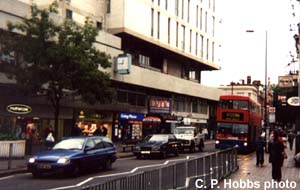 Well, I walked down
Shepherd's Bush Road to the computer store, which wasn't open, so I walked
further down to Hammersmith.
This is a large shopping area, with even a
small American-style mall (Kings Mall) as well as on-street stores. I had
lunch at a sandwich chain called "Benjy's" (all over London), then walked
back up to the
computer store.
The store now had a sign saying "Back in 20 minutes". I waited 30 minutes,
but no-one showed up, so I then caught the #72 bus (it could have been
#220, 283 or 295, my memory is a bit hazy) back to Shepherd's Bush station,
and rode the Underground back to Bayswater.
Well, I walked down
Shepherd's Bush Road to the computer store, which wasn't open, so I walked
further down to Hammersmith.
This is a large shopping area, with even a
small American-style mall (Kings Mall) as well as on-street stores. I had
lunch at a sandwich chain called "Benjy's" (all over London), then walked
back up to the
computer store.
The store now had a sign saying "Back in 20 minutes". I waited 30 minutes,
but no-one showed up, so I then caught the #72 bus (it could have been
#220, 283 or 295, my memory is a bit hazy) back to Shepherd's Bush station,
and rode the Underground back to Bayswater.
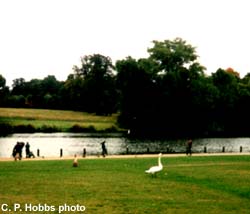 I started by walking
down Inverness Terrace, a quiet residential street to Bayswater Rd, then
walked through the Kensington Gardens. There weren't too many people out,
just a few die-hard joggers and dog -walkers. But it was a nice, quiet,
relaxing walk through the park.
I started by walking
down Inverness Terrace, a quiet residential street to Bayswater Rd, then
walked through the Kensington Gardens. There weren't too many people out,
just a few die-hard joggers and dog -walkers. But it was a nice, quiet,
relaxing walk through the park.
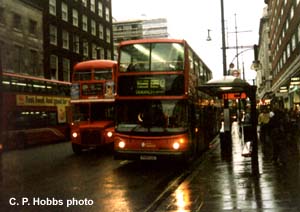 At Marble Arch, Bayswater
Rd changes its name to Oxford Street. I had not noticed earlier, but Oxford
St is limited to buses, bikes and taxis. (Just like State St. in Chicago
about a decade or so ago).
At Marble Arch, Bayswater
Rd changes its name to Oxford Street. I had not noticed earlier, but Oxford
St is limited to buses, bikes and taxis. (Just like State St. in Chicago
about a decade or so ago).
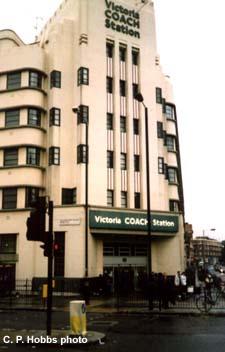 I got off at the
end of the line at Victoria Station. There is the "Victoria Bus Station"
where the red city buses stop, the "Victoria Rail Station" for trains and
the Underground, and the "Victoria Coach Station" for long distance buses
(National Express, Britain's answer to Greyhound)
I got off at the
end of the line at Victoria Station. There is the "Victoria Bus Station"
where the red city buses stop, the "Victoria Rail Station" for trains and
the Underground, and the "Victoria Coach Station" for long distance buses
(National Express, Britain's answer to Greyhound)
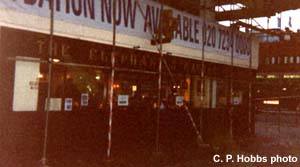 Ok, for those out
there wondering, there's no elephant and there's no castle at Elephant
and Castle. It's just a neighborhood, named after a bar that has
been standing there since the 1800's. There's also a traffic circle full
of cars and buses that can only be negotiated (by pedestrians) using what
the British call a "subway" (underground pedestrian path)
Ok, for those out
there wondering, there's no elephant and there's no castle at Elephant
and Castle. It's just a neighborhood, named after a bar that has
been standing there since the 1800's. There's also a traffic circle full
of cars and buses that can only be negotiated (by pedestrians) using what
the British call a "subway" (underground pedestrian path)
 First stop, the
First stop, the


 The Science Museum...how
can I describe it. Displays on technology in the modern world, gas, diesel
and steam engines, different types of lighting, chemical and nuclear science,
early computers and such...I spent two hours in there and didn't see everything.
(The medical and veternary stuff will have to wait until next trip).
The Science Museum...how
can I describe it. Displays on technology in the modern world, gas, diesel
and steam engines, different types of lighting, chemical and nuclear science,
early computers and such...I spent two hours in there and didn't see everything.
(The medical and veternary stuff will have to wait until next trip).




 The museum was worth
the search. Loaded with historical buses, trains, and even a display of
"London Transport in the Future". (Maglev and flying cars get a mention,
but the main point of the exhibit is alternatives to private autos).
There was a gift shop and I bought a few things, although some prices
seemed high (£3.99--$6 for a
refrigerator magnet
the same size that (Los Angeles) MTA gives us for free?)
The museum was worth
the search. Loaded with historical buses, trains, and even a display of
"London Transport in the Future". (Maglev and flying cars get a mention,
but the main point of the exhibit is alternatives to private autos).
There was a gift shop and I bought a few things, although some prices
seemed high (£3.99--$6 for a
refrigerator magnet
the same size that (Los Angeles) MTA gives us for free?)
 So I got off the
Jubilee at Bank, and walked downstairs to the DLR platforms. (DLR isn't
really "light rail" as we know it...think of it more like the Staten Island
Rapid Transit--without drivers). The route is mostly elevated, with tunnels
in a few places; there are no grade crossings (since there is a third rail,
that's probably a good thing!)
So I got off the
Jubilee at Bank, and walked downstairs to the DLR platforms. (DLR isn't
really "light rail" as we know it...think of it more like the Staten Island
Rapid Transit--without drivers). The route is mostly elevated, with tunnels
in a few places; there are no grade crossings (since there is a third rail,
that's probably a good thing!)
 Since the Underground
doesn't really cover South London (i.e. south of the Thames) particularly
well, conventional trains fill in. These are single-level, 8-10 car electric
commuter trains. Inside, there is 3+2 seating, like the New Jersey Transit
commuter trains. However the routes of London's commuter train network
are much more complex than Chicago's Metra, or anything running out of
New York. A timetable is a must-have. These trains generally run every
30-minutes offpeak and night, 15-minutes or better during peak hours. For
trips within the zones served by the Travelcard, the same Travelcards that
are used for the bus and the Underground are valid on these trains. There
are supposed to be occasional fare inspections (with penalty fares of £5--about
$7.50), for people without the proper ticket. But no one inspected us on
this trip. Again, this was a commuter-type operation for the most part,
with the train dropping off more passengers than it picked up.
Since the Underground
doesn't really cover South London (i.e. south of the Thames) particularly
well, conventional trains fill in. These are single-level, 8-10 car electric
commuter trains. Inside, there is 3+2 seating, like the New Jersey Transit
commuter trains. However the routes of London's commuter train network
are much more complex than Chicago's Metra, or anything running out of
New York. A timetable is a must-have. These trains generally run every
30-minutes offpeak and night, 15-minutes or better during peak hours. For
trips within the zones served by the Travelcard, the same Travelcards that
are used for the bus and the Underground are valid on these trains. There
are supposed to be occasional fare inspections (with penalty fares of £5--about
$7.50), for people without the proper ticket. But no one inspected us on
this trip. Again, this was a commuter-type operation for the most part,
with the train dropping off more passengers than it picked up.
 At Elmers End, I
caught the Croydon Tram headed to Wimbledon. There are three tram routes
in Croydon (a city south of London). The trams are more like what would be
called "light rail" in the U.S. (L.A. Metro Blue Line, San Diego Trolley, Portland Max, etc).
In some places they have their own right-of-way (abandoned railroad line);
elsewhere they run in the street, either in exclusive lanes or in mixed
traffic. In downtown Croydon, the tram operator had to get out and turn
a switch manually for some reason--that probably isn't usual. At this time
of day (about 7 p.m.) ridership was heaviest on trips leaving Croydon.
There was a fare inspection somewhere between Downtown Croydon and Wimbledon;
someone (Not me!) almost was asked to leave the train before he finally dug out his
ticket!
At Elmers End, I
caught the Croydon Tram headed to Wimbledon. There are three tram routes
in Croydon (a city south of London). The trams are more like what would be
called "light rail" in the U.S. (L.A. Metro Blue Line, San Diego Trolley, Portland Max, etc).
In some places they have their own right-of-way (abandoned railroad line);
elsewhere they run in the street, either in exclusive lanes or in mixed
traffic. In downtown Croydon, the tram operator had to get out and turn
a switch manually for some reason--that probably isn't usual. At this time
of day (about 7 p.m.) ridership was heaviest on trips leaving Croydon.
There was a fare inspection somewhere between Downtown Croydon and Wimbledon;
someone (Not me!) almost was asked to leave the train before he finally dug out his
ticket!
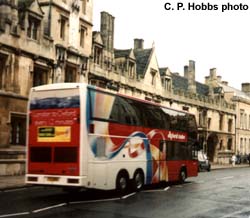 Actually, I had a
choice of two services. "Oxford Tube" (Stagecoach) which runs big German
double-deckers between the two cities and "London-Oxford Express" (Go-Ahead)
which runs single level coaches. Stops vary a small amount, but both companies
run along the Bayswater Road Corridor, then run express to Oxford via the
M40 motorway. They both run very frequently (how about every 12-15 minutes
throughout the day), and cost £8 ($12) round trip; a variety of multiple
ride passes are available too. However, in looking at buses going by, there
didn't seem to be a lot of people on each bus (about 10-12 most of the
time)--is there such a thing as *too much service* ???
Actually, I had a
choice of two services. "Oxford Tube" (Stagecoach) which runs big German
double-deckers between the two cities and "London-Oxford Express" (Go-Ahead)
which runs single level coaches. Stops vary a small amount, but both companies
run along the Bayswater Road Corridor, then run express to Oxford via the
M40 motorway. They both run very frequently (how about every 12-15 minutes
throughout the day), and cost £8 ($12) round trip; a variety of multiple
ride passes are available too. However, in looking at buses going by, there
didn't seem to be a lot of people on each bus (about 10-12 most of the
time)--is there such a thing as *too much service* ???
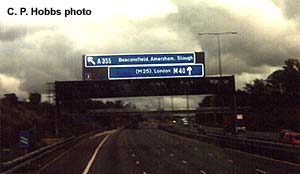 A side note: the
M40 is what we would call a freeway only just outside of the general London
suburbs. Otherwise, it's a divided highway with a few flyovers and underpasses
in certain places. Sometimes, there are houses fronting right on the M40!
A side note: the
M40 is what we would call a freeway only just outside of the general London
suburbs. Otherwise, it's a divided highway with a few flyovers and underpasses
in certain places. Sometimes, there are houses fronting right on the M40!
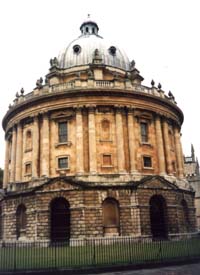 Eventually we arrived
in Oxford, and I got off, walked around the colleges (note to people used
to visiting USC or the UC's, using their libraries, etc--most of the buildings
on Oxford University are *closed* to the public, except for special tours
and such. But it was still fun to look at all those old buildings, and
bask in the rich history...)
Eventually we arrived
in Oxford, and I got off, walked around the colleges (note to people used
to visiting USC or the UC's, using their libraries, etc--most of the buildings
on Oxford University are *closed* to the public, except for special tours
and such. But it was still fun to look at all those old buildings, and
bask in the rich history...)
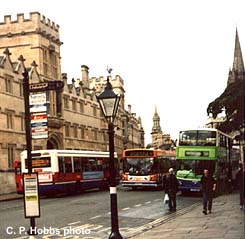
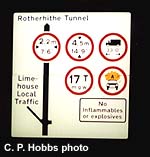 Why to Limehouse?
I was going to try to ride Bus #395, which goes through the Rotherhithe
Tunnel under the Thames. (For more details, see
Why to Limehouse?
I was going to try to ride Bus #395, which goes through the Rotherhithe
Tunnel under the Thames. (For more details, see  The Eurostar terminal
at Waterloo was easy to deal with. There was an airline type security checkpoint
(x-ray machines, metal detectors, etc.) No biggie. Then we went into a
special passengers-only lounge and waited until the train was ready for
boarding.
The Eurostar terminal
at Waterloo was easy to deal with. There was an airline type security checkpoint
(x-ray machines, metal detectors, etc.) No biggie. Then we went into a
special passengers-only lounge and waited until the train was ready for
boarding.
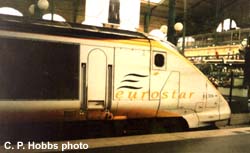 Finally, we boarded
the train. The coaches looked slightly better than the old Amfleet equipment
(bigger windows) and were comfortable but not out and out luxurious. We
left the station around 10:30 and moved out of Southeast England at a decent
rate of speed.
Finally, we boarded
the train. The coaches looked slightly better than the old Amfleet equipment
(bigger windows) and were comfortable but not out and out luxurious. We
left the station around 10:30 and moved out of Southeast England at a decent
rate of speed.
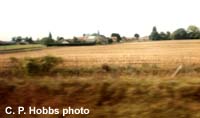 Now we were passing
through the north of France, which was mostly agricultural, except for
a freeway and a few small villages. Because of trackwork, we were delayed
a few times. But soon I started seeing the suburban rail stations flash
by, and I knew that soon we would be in Paris.
Now we were passing
through the north of France, which was mostly agricultural, except for
a freeway and a few small villages. Because of trackwork, we were delayed
a few times. But soon I started seeing the suburban rail stations flash
by, and I knew that soon we would be in Paris.
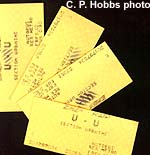 I found the RATP ticket window, and, drawing on my four years of high school
French, asked for a "carnet" of 10 metro tickets. The tickets cost 61 Francs
(about $8, or 80 cents apiece). BTW, "carnet" means "booklet", but these
tickets are loose and separate.
I found the RATP ticket window, and, drawing on my four years of high school
French, asked for a "carnet" of 10 metro tickets. The tickets cost 61 Francs
(about $8, or 80 cents apiece). BTW, "carnet" means "booklet", but these
tickets are loose and separate.
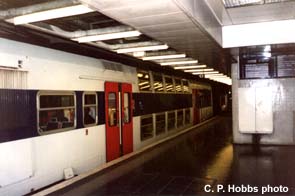 So I walked down to the RER platform and
watched for a while as RER trains (including some amazing double-decker
trains) rolled by...but then I had a strange feeling. Weren't passengers
supposed to *do* something with the tickets before boarding the train?
So I walked down to the RER platform and
watched for a while as RER trains (including some amazing double-decker
trains) rolled by...but then I had a strange feeling. Weren't passengers
supposed to *do* something with the tickets before boarding the train?
 Hmm, now that I have more than a few of the world's subways under
my belt, how did the Paris Metro compare? The cars were nice and
spacious, a bit more so than those of the London Underground. The
stations and trains were reasonably clean and for the most part,
free of grafitti (not so true about the tunnels, though). As in
London, station platforms were equipped with candy and soda
vending machines; unlike in London, these actually worked. On
the other hand, all the garbage cans were sealed off because of
concerns about terrorism (which is hardly a new thing in Paris). So
people left trash on top of the sealed can, or occasionally in
shallow cardboard box tops left in the stations for this purpose.
Hmm, now that I have more than a few of the world's subways under
my belt, how did the Paris Metro compare? The cars were nice and
spacious, a bit more so than those of the London Underground. The
stations and trains were reasonably clean and for the most part,
free of grafitti (not so true about the tunnels, though). As in
London, station platforms were equipped with candy and soda
vending machines; unlike in London, these actually worked. On
the other hand, all the garbage cans were sealed off because of
concerns about terrorism (which is hardly a new thing in Paris). So
people left trash on top of the sealed can, or occasionally in
shallow cardboard box tops left in the stations for this purpose.
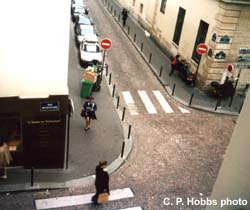

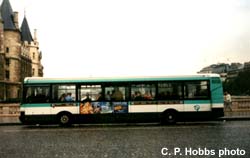 Obviously, the seating layout in the bus was
designed to accomodate the greatest number of standees possible (2 single
rows of seats along the windows, plus a few more in back). There were probably
fewer than 25 seats on this 40-foot bus.
Obviously, the seating layout in the bus was
designed to accomodate the greatest number of standees possible (2 single
rows of seats along the windows, plus a few more in back). There were probably
fewer than 25 seats on this 40-foot bus. 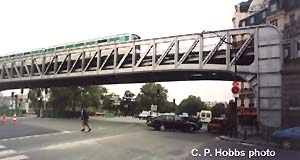 At La Molle, I transferred
to the #6. This is one of the lines which uses rubber tired trains; the
ride is smooth and quiet. Parts of this line are elevated, which reminded me of
the Chicago 'L'.
At La Molle, I transferred
to the #6. This is one of the lines which uses rubber tired trains; the
ride is smooth and quiet. Parts of this line are elevated, which reminded me of
the Chicago 'L'.
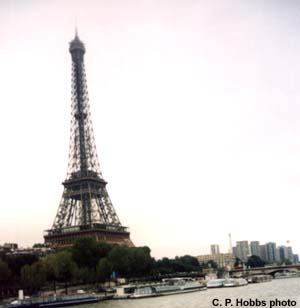 I got off at Bir-Hakeim station, walked under the bridge and there it was...
the Eiffel Tower, in all its fog shrouded glory. I took a few pictures
as I crossed the Seine and walked along Bl. New York toward the Place de
l'Alma (Diana memorial).
I got off at Bir-Hakeim station, walked under the bridge and there it was...
the Eiffel Tower, in all its fog shrouded glory. I took a few pictures
as I crossed the Seine and walked along Bl. New York toward the Place de
l'Alma (Diana memorial).
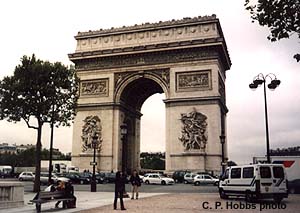

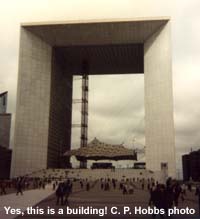
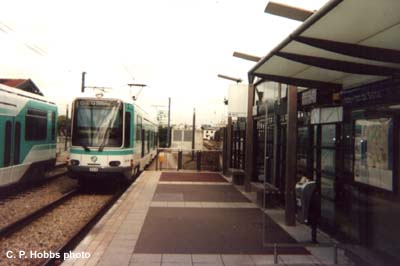 In addition to buses
and the Metro, RATP runs two light rail lines, called "tramways". One runs
in the suburbs just north of Paris, the other (which I rode) runs along
the river along the west side of Paris.
In addition to buses
and the Metro, RATP runs two light rail lines, called "tramways". One runs
in the suburbs just north of Paris, the other (which I rode) runs along
the river along the west side of Paris.
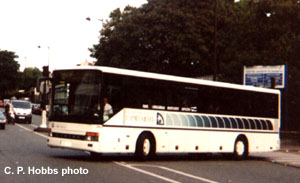
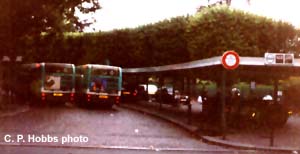
 I
started off this day by taking the Metro #7 to Chatelet. After hanging
out there for about an hour, I walked along Rue Rivoli to the
I
started off this day by taking the Metro #7 to Chatelet. After hanging
out there for about an hour, I walked along Rue Rivoli to the

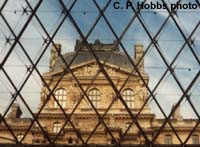 I got off at Chatelet, and walked back
to the Louvre. This time I went in (through the pyramid, where there is
an airport-style security check)
I got off at Chatelet, and walked back
to the Louvre. This time I went in (through the pyramid, where there is
an airport-style security check)


 The train (another SNCF double-decker) was slow, also marred by a bit of
graffitti, and the tunnel smelled smoky, though the trains are electric.
But there were a few great views of the Seine and the Eiffel Tower. The
train I was on seemed almost empty, although there was a big crowd at the
Notre Dame station and again at the Bibliothèque François-Mitterand
station.
The train (another SNCF double-decker) was slow, also marred by a bit of
graffitti, and the tunnel smelled smoky, though the trains are electric.
But there were a few great views of the Seine and the Eiffel Tower. The
train I was on seemed almost empty, although there was a big crowd at the
Notre Dame station and again at the Bibliothèque François-Mitterand
station.
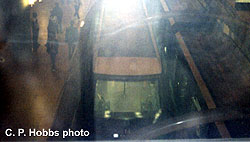 At the Bibliothèque
François-Mitterand station, I didn't get out to see the library
(it was after 6 p.m and undoubtedly closed) but I did catch RATP's newest
Metro line, the #14. This train looks and sounds like something
out of a science-fiction movie, and has platform
doors (de rigueur for all new Metro lines in Europe?)The train I was riding on was only
about 1/2 full, but the trains going in the opposite direction were packed.
At the Bibliothèque
François-Mitterand station, I didn't get out to see the library
(it was after 6 p.m and undoubtedly closed) but I did catch RATP's newest
Metro line, the #14. This train looks and sounds like something
out of a science-fiction movie, and has platform
doors (de rigueur for all new Metro lines in Europe?)The train I was riding on was only
about 1/2 full, but the trains going in the opposite direction were packed.
 The
plan was to visit the flea market in
The
plan was to visit the flea market in
 There were plenty
of buses to look at, though, including a few older asthmatic- sounding Renaults.
None with the open rear platform, though--those might have gone the way
of the open-air "pissoir" on the streets of Paris.
(
There were plenty
of buses to look at, though, including a few older asthmatic- sounding Renaults.
None with the open rear platform, though--those might have gone the way
of the open-air "pissoir" on the streets of Paris.
(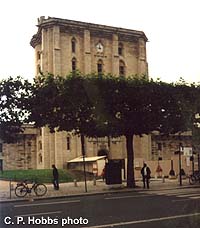

 It
started to rain, so I scratched Parc Villette from my trip plan. Also on
the cutting room floor--Versailles, since that really merits a whole day
(besides, the rail line leading there was temporarily out of service for
repairs....)
It
started to rain, so I scratched Parc Villette from my trip plan. Also on
the cutting room floor--Versailles, since that really merits a whole day
(besides, the rail line leading there was temporarily out of service for
repairs....)
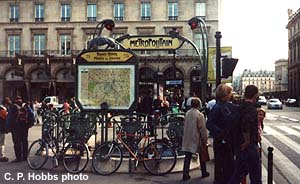 I got as far as the Louvre when it started to rain real hard. Not wanting
to get soaked, I decided to take the metro back to my hotel.
I got as far as the Louvre when it started to rain real hard. Not wanting
to get soaked, I decided to take the metro back to my hotel. About 2 hours later,
I decided to take another walk. So I walked north past Notre Dame and the
Hotel de la Ville, where a big pile of shoes had been assembled, in support
of people injured by land mines around the world. I went to the internet
cafe where I'm now doing this write-up.
About 2 hours later,
I decided to take another walk. So I walked north past Notre Dame and the
Hotel de la Ville, where a big pile of shoes had been assembled, in support
of people injured by land mines around the world. I went to the internet
cafe where I'm now doing this write-up.
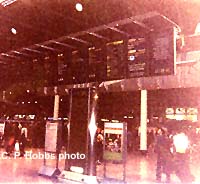 At Waterloo, there was a short passport checking line for EU residents,
and a longer one for "everyone else". When asked, I told the passport agent
I was on my way straight to Heathrow. No problem.
At Waterloo, there was a short passport checking line for EU residents,
and a longer one for "everyone else". When asked, I told the passport agent
I was on my way straight to Heathrow. No problem.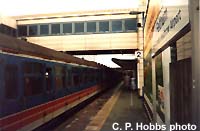 At Feltham station (bus connection to Heathrow), the lift...oops,
elevator was broken, so there were a few stairs to climb.
At Feltham station (bus connection to Heathrow), the lift...oops,
elevator was broken, so there were a few stairs to climb.